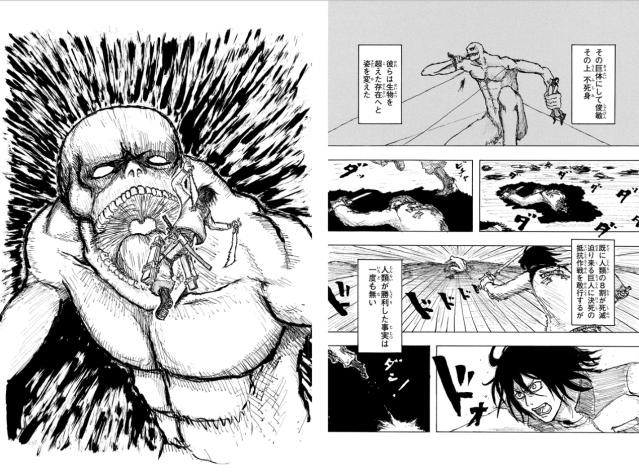
Once upon a time Eren and Levi were the same person, and the best defense against the Titans was…a bunch of trees?!?
Publisher Shueisha’s Weekly Shonen Jump is the perennial best-seller among manga anthologies in Japan, being the serialized home of such iconic series as One Piece, Dragon Ball, Naruto, Bleach, and Death Note. But there’s one extremely noticeable absence in the Shonen Jump hit parade, and that’s Attack on Titan.
Creator Hajime Isayama isn’t to blame for that, though, since he did pitch the smash hit series to Shonen Jump, only to receive a lukewarm response and take his work to rival Kodansha, who was enthusiastic enough to start serializing it in its Bessatsu Shonen Magazine. Now Kodansha is giving everyone a chance to experience the prototype-version of Attack on Titan, titled Humanity vs. Titans, through its Magazine Debut website. Isayama’s 65-page self-contained tale, which he wrote and illustrated at the age of 19, can be read in its entirety and contains some interesting differences from what Attack on Titan would eventually become, as well as a few plot points that survived and even a possible hint at how the series could end.
漫画投稿サイト「マガジンデビュー」!
— 漫画編集者・川窪 (@ShingekiKyojin) November 3, 2018
期間限定で諫山さんが週刊少年マガジンに初めて持ち込んだ「進撃の巨人」を投稿中
他にも新人漫画家たちの面白い作品がたくさん投稿されています!
ジャンルは不問!デビューを目指すすべての新人漫画家の皆さん、投稿待ってます!https://t.co/pexZ4zg2sA
One of the biggest differences is that Humanity vs. Titans lays out the Titans origins right from the start, saying that they were created by a group of religious fanatics in order to protect nature from the devastating effects of human society. The titans were designed to kill as many humans as possible, and in the hundred years they’ve been around when the story takes place, they’ve wiped out 80 percent of the species. This reverence for nature even influences the setting, as instead of living in cities surrounded by protective brick walls, the remaining humans in Humanity vs. Titans live at the center of a ring of towering trees, as the Titans refuse to destroy plant life.
▼ In the world of Humanity vs. Titans, this would make a great bunker.
The Titans in Humanity vs. Titans share the final version’s taste for human flesh and regenerative properties, but instead of having a uniform weak spot at the base of their necks, each has a central nucleus located somewhere in their body that must be crushed in order to kill the beast.
As for the human cast, Humanity vs. Titans’s male lead, Murakumo, seems to have more in common with Attack on Titan fan favorite Levi, as he’s a cool, capable warrior, and also the only human to have ever survived a fight with a Titan. He does share Attack on Titan protagonist Eren’s ability to shift into a Titan, though, as well as his backstory of having a parent (actually both parents in Murakumo’s case) been eaten by Titans.
There’s also an early version of female lead Mikasa, although here she’s named Tsubaki, and instead of being a full-fledged soldier herself, she’s a civilian who’s begging Murakumo, who she calls “Master,” to teach her to fight, so that she can avenge her parents, who were also eaten by Titans.
Sadly, that’s a wish she never gets granted, since at the end of Humanity vs. Titans’s one and only chapter, Murakumo sacrifices himself in order to protect the town from a rampaging Titan, in keeping with his declaration that unlike Tsubaki, he’s not fighting for revenge, but for the sake of his friends who’re still among the living. The story comes to a close with Tsubaki practicing her sword technique in front of Murakumo’s grave, which could be a sign that the ending for Attack on Titan that Isayama has in his head is one characterized more by catharsis than triumph (or maybe he just needed a compact story with a strong emotional ending while he was shopping the concept around).
Magazine Debut even includes part of the feedback Isayama was given by the publication’s editors:
“We think that if you hold on to your desire to convey your story to an audience, and to have them read it, that you can become a professional manga artist.”
Thirteen years later, Isayama isn’t just any manga pro, but on of the most successful in the industry, and if you want to get a look at how it all started, Humanity vs. Titans can be found here.
Source: Magazine Debut via Jin
Top image: Magazine Debut
Insert images: Pakutaso


 Ending date for Attack on Titan announced, and it’s startlingly soon
Ending date for Attack on Titan announced, and it’s startlingly soon Attack on Titan’s final, series-ending scene revealed by franchise creator
Attack on Titan’s final, series-ending scene revealed by franchise creator Attack on Titan editor: Manga to end in 3-4 years
Attack on Titan editor: Manga to end in 3-4 years Attack on Titan creator reveals marriage while running down his favorite movies of the year
Attack on Titan creator reveals marriage while running down his favorite movies of the year “Is Attack on Titan any good?” customer asks Japanese fried chicken chef – and for a good reason
“Is Attack on Titan any good?” customer asks Japanese fried chicken chef – and for a good reason Disillusionment at Tsukiji’s tourist-target prices led us to a great ramen restaurant in Tokyo
Disillusionment at Tsukiji’s tourist-target prices led us to a great ramen restaurant in Tokyo Japan may add Japanese language proficiency, lifestyle classes to permanent foreign resident requirements
Japan may add Japanese language proficiency, lifestyle classes to permanent foreign resident requirements Pizza Hut releases a turtle pizza that looks like a Teenage Mutant Ninja Turtle
Pizza Hut releases a turtle pizza that looks like a Teenage Mutant Ninja Turtle Is the all-you-can-eat KFC buffet in Tokyo really as good as they say it is?
Is the all-you-can-eat KFC buffet in Tokyo really as good as they say it is? The best cosplayers from Day One of the Ikebukuro Halloween Cosplay Festival
The best cosplayers from Day One of the Ikebukuro Halloween Cosplay Festival We take a ride on Seibu Railway’s futuristic luxury liner: the Limited Express Laview
We take a ride on Seibu Railway’s futuristic luxury liner: the Limited Express Laview Cup Noodle sells new squid fork with its instant ramen
Cup Noodle sells new squid fork with its instant ramen AR sport Hado added to Shizuoka high school curriculum
AR sport Hado added to Shizuoka high school curriculum Japanese photographer shrink-wraps strangers to capture love in Tokyo 【Photos】
Japanese photographer shrink-wraps strangers to capture love in Tokyo 【Photos】 Merry Christmas from SoraNews24!
Merry Christmas from SoraNews24! 7-Eleven Japan starts new temporary luggage storage service in over 300 branches
7-Eleven Japan starts new temporary luggage storage service in over 300 branches Starbucks teams up with 166-year-old Kyoto doll maker for Year of the Horse decorations【Photos】
Starbucks teams up with 166-year-old Kyoto doll maker for Year of the Horse decorations【Photos】 Tokyo’s Tsukiji sushi neighborhood asks tour groups to stay away for the rest of the month
Tokyo’s Tsukiji sushi neighborhood asks tour groups to stay away for the rest of the month Starbucks Japan releases new zodiac chilled cup drink for 2026
Starbucks Japan releases new zodiac chilled cup drink for 2026 Street Fighter Hadouken Churros to be launched and eaten in Tokyo, Okami pudding on offer too
Street Fighter Hadouken Churros to be launched and eaten in Tokyo, Okami pudding on offer too Is this the most relaxing Starbucks in Japan?
Is this the most relaxing Starbucks in Japan? Starbucks on a Shinkansen bullet train platform: 6 tips for using the automated store in Japan
Starbucks on a Shinkansen bullet train platform: 6 tips for using the automated store in Japan Large amount of supposed human organs left in Osaka marketplace
Large amount of supposed human organs left in Osaka marketplace Japan’s human washing machines will go on sale to general public, demos to be held in Tokyo
Japan’s human washing machines will go on sale to general public, demos to be held in Tokyo Japanese train company is letting fans buy its actual ticket gates for their homes
Japanese train company is letting fans buy its actual ticket gates for their homes Tokyo considering law requiring more trash cans following litter increase in heavily touristed area
Tokyo considering law requiring more trash cans following litter increase in heavily touristed area Is China’s don’t-go-to-Japan warning affecting tourist crowds in Tokyo’s Asakusa neighborhood?
Is China’s don’t-go-to-Japan warning affecting tourist crowds in Tokyo’s Asakusa neighborhood? Nintendo’s Kirby now delivering orders at Kura Sushi restaurants, but not in Japan
Nintendo’s Kirby now delivering orders at Kura Sushi restaurants, but not in Japan Tokyo event lets you travel back in time, for free, to celebrate 100 years since Showa era start
Tokyo event lets you travel back in time, for free, to celebrate 100 years since Showa era start Survey asks foreign tourists what bothered them in Japan, more than half gave same answer
Survey asks foreign tourists what bothered them in Japan, more than half gave same answer Japan’s deadliest food claims more victims, but why do people keep eating it for New Year’s?
Japan’s deadliest food claims more victims, but why do people keep eating it for New Year’s? We deeply regret going into this tunnel on our walk in the mountains of Japan
We deeply regret going into this tunnel on our walk in the mountains of Japan Studio Ghibli releases Kodama forest spirits from Princess Mononoke to light up your home
Studio Ghibli releases Kodama forest spirits from Princess Mononoke to light up your home Major Japanese hotel chain says reservations via overseas booking sites may not be valid
Major Japanese hotel chain says reservations via overseas booking sites may not be valid Put sesame oil in your coffee? Japanese maker says it’s the best way to start your day【Taste test】
Put sesame oil in your coffee? Japanese maker says it’s the best way to start your day【Taste test】 The top 10 annoying foreign tourist behaviors on trains, as chosen by Japanese people【Survey】
The top 10 annoying foreign tourist behaviors on trains, as chosen by Japanese people【Survey】 No more using real katana for tourism activities, Japan’s National Police Agency says
No more using real katana for tourism activities, Japan’s National Police Agency says Starbucks Japan reveals new sakura drinkware collection, inspired by evening cherry blossoms
Starbucks Japan reveals new sakura drinkware collection, inspired by evening cherry blossoms Attack on Titan x Uniqlo pairing unleashes a colossal collaboration on the world
Attack on Titan x Uniqlo pairing unleashes a colossal collaboration on the world Mickey Manga Mouse – Attack on Titan creator, other manga stars draw the Disney icon【Pics】
Mickey Manga Mouse – Attack on Titan creator, other manga stars draw the Disney icon【Pics】 Attack on Titan’s creator estimates manga will end in three years
Attack on Titan’s creator estimates manga will end in three years Attack on Titan creator says he didn’t write crazed, raunchy rant in manga’s latest chapter
Attack on Titan creator says he didn’t write crazed, raunchy rant in manga’s latest chapter Kodansha promises worldwide prosecution of illegal uploaders of Attack on Titan
Kodansha promises worldwide prosecution of illegal uploaders of Attack on Titan Attack on Titan author offers message of support, artwork for the people of Kumamoto
Attack on Titan author offers message of support, artwork for the people of Kumamoto Live-action Attack on Titan confirmed for 2 films
Live-action Attack on Titan confirmed for 2 films Want more Attack on Titan? Make sure you’re in Japan winter 2014!
Want more Attack on Titan? Make sure you’re in Japan winter 2014! Attack on Avengers! Attack on Titan’s female giant heading to New York to fight Marvel heroes
Attack on Avengers! Attack on Titan’s female giant heading to New York to fight Marvel heroes Kodansha’s 1st sales jump in 18 years credited to Attack on Titan
Kodansha’s 1st sales jump in 18 years credited to Attack on Titan Attack on Titan star Levi graces cover of Japanese women’s magazine
Attack on Titan star Levi graces cover of Japanese women’s magazine We are officially colossal with these free Attack on Titan face packs! 【Photos】
We are officially colossal with these free Attack on Titan face packs! 【Photos】 Attack on Titan Season 2’s premiere date is finally, FINALLY announced
Attack on Titan Season 2’s premiere date is finally, FINALLY announced Live-Action Attack on Titan films’ poster, 2nd movie title unveiled
Live-Action Attack on Titan films’ poster, 2nd movie title unveiled Trailer for Attack on Titan’s last season finally released, looks awesome despite studio changes
Trailer for Attack on Titan’s last season finally released, looks awesome despite studio changes
Leave a Reply